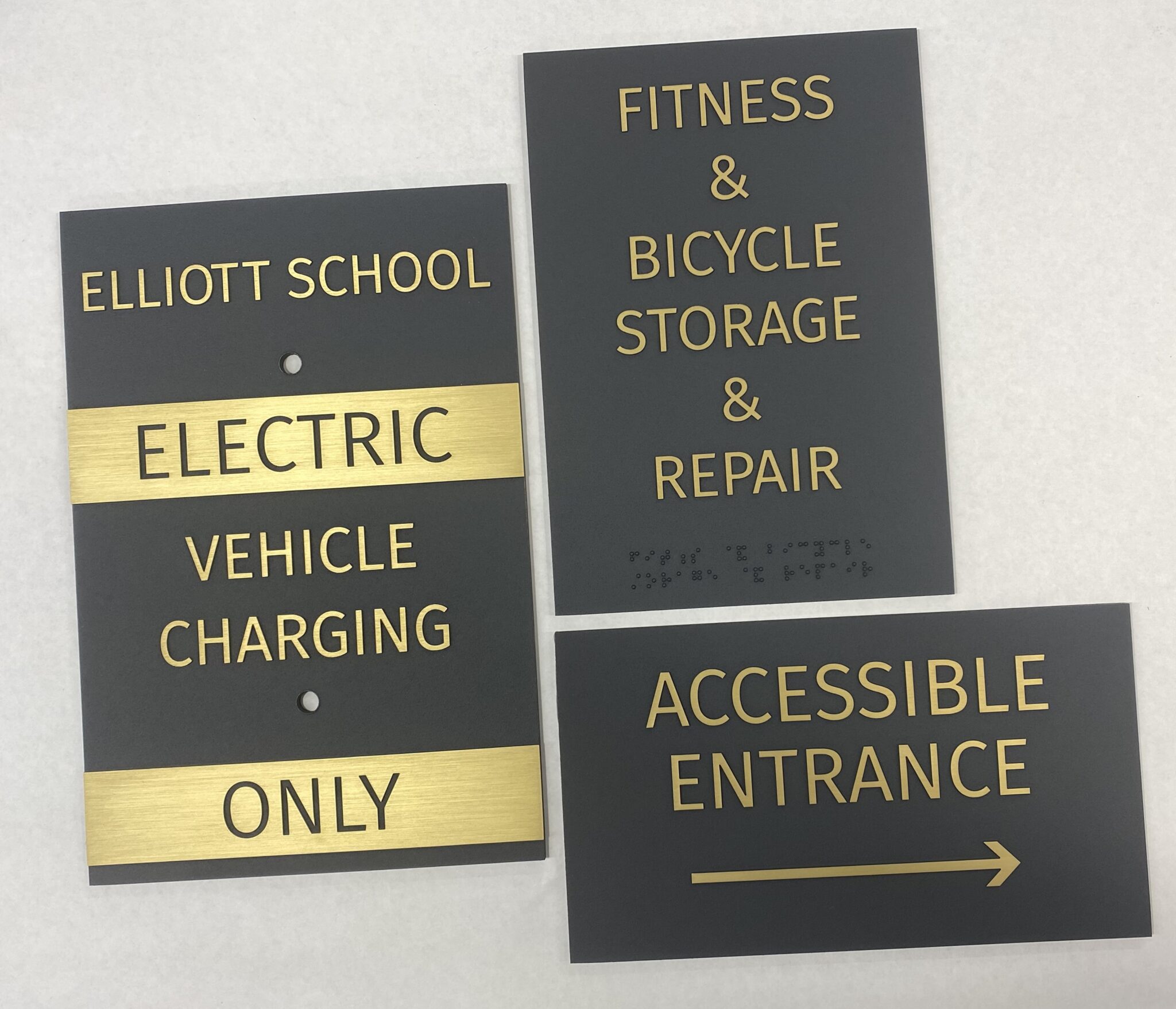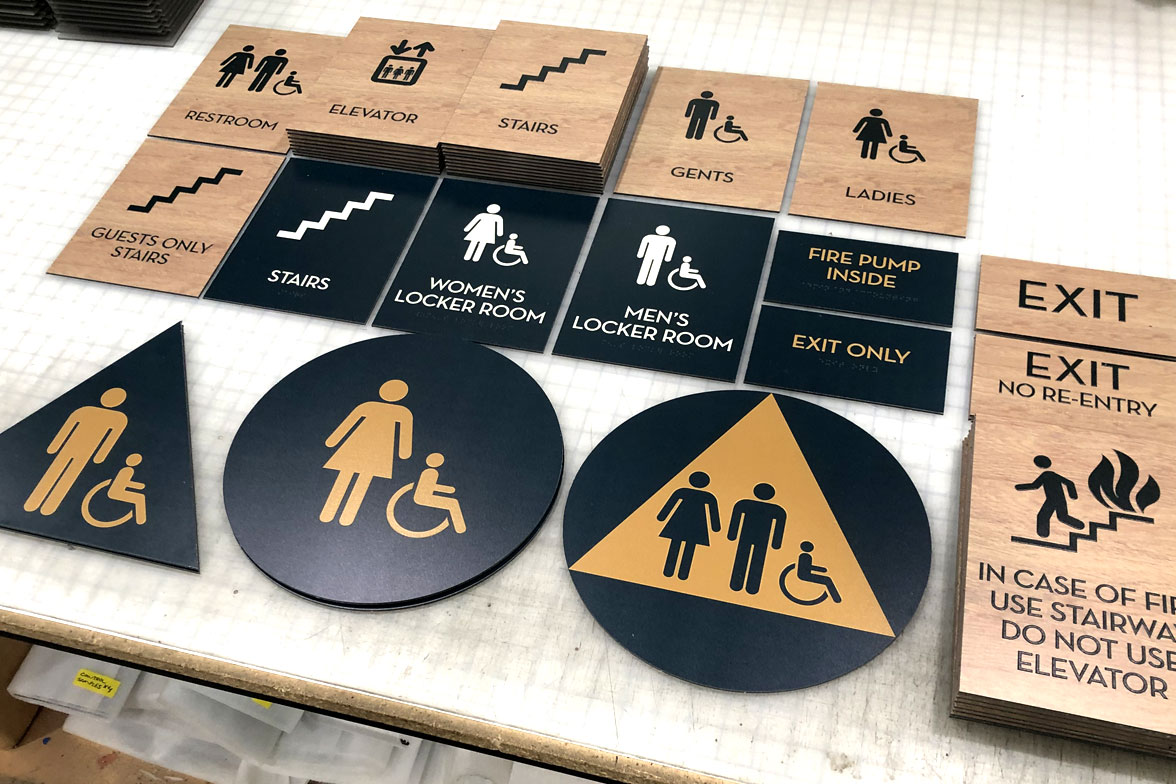ADA Signs: Essential Devices for Inclusive Environments
ADA Signs: Essential Devices for Inclusive Environments
Blog Article
ADA Signs: Making Sure Ease Of Access and Compliance in Public Spaces
ADA signs plays an essential function in ensuring availability and conformity within public areas, dramatically adding to a comprehensive setting for people with disabilities. As we explore the nuances of ADA signage, from tactile features to develop ins and outs, it's critical to consider how these elements coalesce to support the legal rights of all individuals.
Value of ADA Signs
In contemporary society, the importance of ADA signage extends beyond plain conformity with lawful requireds to symbolize a commitment to inclusivity and ease of access for all individuals. These signs are important in creating environments where people with specials needs can navigate public rooms with the exact same simplicity and independence as those without disabilities. By giving standardized and clear information, ADA signs makes certain that everybody can access facilities, services, and details without obstacles.
The relevance of ADA signs hinges on its capacity to enhance the lifestyle for people with handicaps by promoting equivalent accessibility. It removes the barriers that could otherwise prevent their capability to get involved completely in area life. These indicators offer as visible indicators of a company's commitment to variety and equality, showing broader social worths that champion the civil liberties and dignity of all individuals.
Moreover, ADA signage plays an essential function in public safety. By assisting people to exits, bathrooms, and various other vital facilities, it makes sure that all individuals, despite physical capability, can leave securely during emergencies. In recap, ADA signs is not just a regulatory demand yet an effective tool for cultivating a inclusive and equitable culture.
Crucial Element of Conformity

Placement is crucial; indications need to be installed in places that are quickly visible and reachable. Normally, signs needs to be placed in between 48 and 60 inches from the ground to make certain access for both standing and mobility device individuals. Tactile elements, such as Braille, are important for individuals with aesthetic disabilities, supplying vital info in a non-visual layout.
High-contrast shades between the message and history are needed to improve readability for individuals with low vision. The ADA mandates specific comparison ratios to ensure quality. In addition, character size is a vital factor to consider, with minimal height needs determined by the seeing range to make sure readability from numerous angles.
Style Considerations for Accessibility
Creating available signage needs a meticulous method to guarantee it satisfies the needs of all individuals, particularly those with handicaps. This includes considering different layout components that enhance readability and functionality. Secret elements consist of the choice of typeface, color comparison, and responsive attributes. Typefaces must be sans-serif, with straightforward and clear letterforms, to help with very easy reading. The dimension of the message is equally essential, with ADA guidelines suggesting a minimal height based upon watching range to guarantee readability.
Contrasting shades in between message and history are essential for visibility, especially for people with aesthetic impairments. A high contrast ratio assists differentiate the message from its history, boosting readability under various lighting conditions. Additionally, tactile aspects, such as Braille and increased personalities, are vital for individuals who are blind or have low vision. These components need to be found at a constant elevation and placement to guarantee very easy gain access to and comprehension.
Moreover, the positioning of signs plays a substantial duty in accessibility. Signs should be installed in places that are unblocked and easily reachable. Ensuring that signage is mounted at appropriate heights and angles allows all customers, consisting of those making use of mobility devices, to interact with them effectively.
Common Mistakes to Stay Clear Of

An additional common error is the wrong placement of signage. ADA guidelines define specific elevation and place demands to make sure that indications are conveniently visible and obtainable by all individuals, including those utilizing mobility devices. Ignoring these standards not only interferes with ease of access yet additionally runs the risk of non-compliance with lawful standards.
Furthermore, not enough contrast in between message and background is a constant oversight. Sufficient comparison is vital for readability, specifically for individuals with low vision. Developers occasionally select colors that are visually find out here now attractive yet do not have the necessary contrast, providing the message difficult to discern.
Finally, some developers fall short to incorporate tactile aspects, such as Braille, which are essential for individuals who are blind. Omitting these functions not just causes non-compliance with ADA regulations but also restricts access for a section of the population that relies upon responsive details.
Future Trends in Signs
Improvements in modern technology and enhancing understanding of inclusivity are forming the future patterns in signage style. Digital signage, for instance, is evolving to include real-time updates and interactive functions, which can be essential in offering dynamic info in public spaces.
An additional emerging trend is the use of increased reality (AR) to improve individual experience. AR-enabled signage can overlay digital details onto the physical environment, supplying aesthetically impaired people with auditory or haptic feedback. ADA Signs. This modern technology not only enhances ease of access however also creates an engaging experience for all customers
Sustainability is also a substantial aspect influencing signs fads. Environment-friendly materials and energy-efficient illumination remedies are being prioritized to line up with click this international environmental objectives. Moreover, improvements in products science are resulting in the advancement of even more weather-resistant and sturdy signs.
Verdict
ADA signage plays an important duty in assuring accessibility and compliance within public areas by integrating responsive components, high-contrast shades, and strategic placement. The adherence to ADA requirements not just promotes secure navigating for people with handicaps but also symbolizes a company's commitment to variety and inclusivity. By preventing typical errors and embracing future trends, public spaces can remain to advance these values, guaranteeing that the rights and dignity of all people are valued and promoted.
ADA signs plays an indispensable role in guaranteeing accessibility and compliance within public rooms, significantly adding to a comprehensive environment for individuals with impairments. As we explore the nuances of ADA signs, from tactile features to create ins and outs, it's vital to take into consideration just how these aspects coalesce to copyright the civil liberties of all individuals.In contemporary culture, the relevance of ADA signage extends past simple compliance with lawful mandates to embody a dedication to inclusivity and ease of access for all people. By supplying clear and standardized details, ADA signage makes sure that everyone can access centers, solutions, and info without obstacles.
ADA signage plays an essential role in guaranteeing ease of access and compliance within public spaces by including responsive elements, high-contrast colors, and critical placement. (ADA Signs)
Report this page